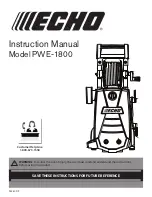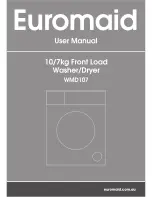
6
INSTALLATION
INSTALLATION
INSTALLATION UNDER A WORK PLAIN
The positioning of the machine
under a work plan, can only happen
if the housing compartment has the
following dimensions of width of 76
cm and of height of 85 cm. It should
also be considered that the machine
needs a approximately 5 cm behind
from the wall. An example of a typical
installation is shown in the illustration
below. The superior cover (TOP) of the
machine must not be removed for
reasons of electrical and mechanical
safety.
WATER SUPPLY CONNECTION
The water inlet hose must be
connected to a tap of cold water with
a 3/4” threaded mouth.
Use only the supplied water inlet hose.
Avoid the use of old hoses or hoses
used previously.
N.B. The hose is already
complete with rubber gasket,
if this is missing, the tube
must not be used.
If the water supply system is new or
has been inactive for too long, it will
be necessary to allow the water run
until the it appears clear.
WATER DRAINAGE
Drain hose can be installed in two diff erent ways:
• On the edge of sink using the plastic hose hanger commercially available.
In this case make sure that the tube is secured to the sink.
• In a drain pipe at a height of not less than 60 cm and not more than 90cm.
The tube end must always be ventilated, i.e. the inside diameter of the drain pipe
must be larger than the outer diameter of the drain hose of the washing machine.
The drain hose must not be obstructed.
Example of installation
LIQUID DETERGENT BULKHEAD PAN
Inside the kit supplied, there is
a bulkhead pan of blue colour
which grants the use of liquid
detergents in the washing
machine.
To install a bulkhead it is
necessary to:
• remove the detergent
drawer from the washing
machine
• apply the bulkhead
as shown in photo
(see fi gure 7)
After installation, replace the
drawer into the washing machine.
There is no need to remove the
bulkhead (see p. 22).
FIRST USE
Before the normal washing operation a wash cycle of with the cotton
programme at 80°C must be run with detergent and without laundry.
POWER SUPPLY CONNECTION
The machine is equipped with a connecting cable and earthed schuko plug for
connection to AC 230 V ~ 50 Hz.
Make sure the schuko plug is always accessible to unplug the machine from the
mains. The electrical power system must be designed according to VDE 0100. It
is recommend not to connect, in any case, the machine with extension cords,
multiple power sockets, etc to avoid overheating which are sources of potential fi re
hazard. The manufacturer declines any responsibility for damages due to failure or
inappropriate protective connecting point.
To enhance safety, VDE in the directive DIN VDE 0100 in section 739, has
recommended to install a circuit breaker (RCD) with a tripping current of 30 mA (DIN
VDE 0664).
If using a diff erential circuit breaker, make sure it is type A, according to DIN VDE 0664
and current sensitive buttons.
The rating plate provides information on rated current absorption and relating
protection. Compare these data with the power supply.
ELECTRICAL SHOCK HAZARD
NOT KEEPING TO THIS INSTRUCTION COULD ENDANGER THE USER.
THIS WASHING MACHINE REQUIRES EARTH WIRING.
For personal safety, this washing machine must be grounded.
This washing machine is equipped with a power cord (A) and with a plug (B).
To minimize the risk of electric shock, the cable must be plugged into socket (C) that
fi ts the plug (B).
If the socket is not available, it will be sole responsibility and duty of the user to have
it installed by a qualifi ed electrician.
Do not change/modify the power cord and do not use adapters or extension cables
(D).
N.B. It is not recommend using extension on the drain hose.
Summary of Contents for WID1290
Page 51: ......







































